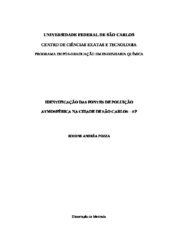| dc.contributor.author | Pozza, Simone Andréa | |
| dc.date.accessioned | 2016-06-02T19:56:55Z | |
| dc.date.available | 2005-06-07 | |
| dc.date.available | 2016-06-02T19:56:55Z | |
| dc.date.issued | 2005-03-23 | |
| dc.identifier.citation | POZZA, Simone Andréa. Identificação das fontes de poluição atmosférica na cidade de São Carlos-SP.. 2005. 119 f. Dissertação (Mestrado em Ciências Exatas e da Terra) - Universidade Federal de São Carlos, São Carlos, 2005. | por |
| dc.identifier.uri | https://repositorio.ufscar.br/handle/ufscar/4143 | |
| dc.description.abstract | The quality of the atmospheric air is of great importance for the health of the population. Among the quantifiable aspects of the air quality, one can find the particulate matter (PM) concentration in the atmosphere, whose fine (PM10) and ultra-fine (PM2.5) fractions have been extensively studied, as these particle size
fractions are particularly damaging for the human health. The main objective of this work was the identification of emission sources of breathable particulate matter, as well as the quantification of their relative participation in the formation of the air pollution in São Carlos/SP, with the use of the reception model. The experiments used the dichotomous sampler for the collection of the particulate matter. Samples were taken in the receptor site, at the city center, in one year period. Also, the emission profiles of local sources (soil, vehicular emission, road dust re-suspension, sugar cane burning and vegetable burning) were measured. The mass concentration was obtained by weighing the sample filters before and after collection. The filter were then submitted to XRF analysis, and 14 chemical elements were quantified (Al, Si, P, S, Cl, K, Ca, Ti, Cr, Mn, Fe, Cu, Zn, Pb). Moreover, carbon detection was carried out by the DIC (dissolved inorganic
carbon) and DOC (dissolved organic carbon) techniques. These values were fed to the EPA s CMB8 computer pack that calculates the relative contributions of the sources in the reception site. The results show the seasonal dependence of the sources in São Carlos, with the important presence of the vehicular emissions in the whole year. For the fine fraction, the contribution of the sugar cane burning was significant, in the dry season. In the ultra-fine fraction, an appreciable amount of secondary sulfur was found. The comparison between the source contributions calculated from the results of these work with those calculated utilizing data from the EPA´s SPECIATE library revealed very different profiles, confirming the importance of utilizing local sources in the modeling. | eng |
| dc.description.sponsorship | Universidade Federal de Sao Carlos | |
| dc.format | application/pdf | por |
| dc.language | por | por |
| dc.publisher | Universidade Federal de São Carlos | por |
| dc.rights | Acesso Aberto | por |
| dc.subject | Aerossóis | por |
| dc.subject | Perfil de fonte | por |
| dc.subject | Material particulado | por |
| dc.subject | Poluição atmosférica | por |
| dc.subject | CBM8 | por |
| dc.title | Identificação das fontes de poluição atmosférica na cidade de São Carlos-SP. | por |
| dc.type | Dissertação | por |
| dc.contributor.advisor1 | Coury, José Renato | |
| dc.contributor.advisor1Lattes | http://genos.cnpq.br:12010/dwlattes/owa/prc_imp_cv_int?f_cod=K4787098Y6 | por |
| dc.description.resumo | A qualidade do ar respirável é um fator de grande importância na saúde de uma população. Dentre os aspectos analisáveis dessa qualidade, encontra-se a
quantidade de material particulado (MP) presente na atmosfera, cuja fração fina (MP10) e a superfina (MP2.5) são o foco de amplos estudos, por serem inaláveis no trato respiratório humano. O principal objetivo deste trabalho é a identificação de
fontes emissoras de material particulado respirável, bem como a quantificação de suas participações relativas na formação da poluição na cidade de São Carlos/SP, com o uso do modelo receptor. Os experimentos utilizaram o equipamento
dicotômico para a coleta do material particulado. Foram realizados monitoramentos do sítio receptor, localizado no centro da cidade de São Carlos,
pelo período de um ano. Também foram determinados os perfis de emissão de fontes locais (solo, emissão veicular, ressuspensão, queimada de cana de açúcar e queimada de vegetação). A concentração mássica foi obtida por gravimetria
pesando-se os filtros antes e após a amostragem. Os filtros foram submetidos à análise de elementos traços por XRF, sendo quantificada a presença de 14 elementos químicos (Al, Si, P, S, Cl, K, Ca, Ti, Cr, Mn, Fe, Cu, Zn, Pb). Além disso, foi efetuada a determinação de carbono, por DIC (Carbono Inorgânico Dissolvido) e DOC (Carbono Orgânico Dissolvido). Os resultados foram cruzados
através do programa CMB8 e apontam para uma dependência sazonal das fontes emissoras, onde se destacam as fontes relativas ao solo e à emissão veicular. No caso da fração fina, a contribuição da queimada de cana de açúcar é significativa,
no período seco. Na fração superfina observou-se a presença muito representativa de enxofre secundário. A comparação da distribuição de fontes entre aquela obtida com resultados desse trabalho com aquela obtida exclusivamente do SPECIATE
revelou mudanças significativas no perfil obtido, confirmando a importância da utilização de perfis de fontes obtidas localmente. | por |
| dc.publisher.country | BR | por |
| dc.publisher.initials | UFSCar | por |
| dc.publisher.program | Programa de Pós-Graduação em Engenharia Química - PPGEQ | por |
| dc.subject.cnpq | ENGENHARIAS::ENGENHARIA QUIMICA | por |
| dc.contributor.authorlattes | http://lattes.cnpq.br/5530984461673946 | por |
